Forklift Propane Tank: Installation Guide [with expert tips]

Forklift Propane Tanks are used in industries to enhance their efficiency and power the emission of gases compared to other fuels. Correct installation of propane tanks is necessary to enhance the overall performance of the business operations and improve safety. This is precisely the same process used to keep the lift trucks running. This guide will provide the steps for an easy and hassle-free installation of propane tanks for forklifts.
Pre Installation Precautions
Before starting the installation process, ensure that you are taking proper safety measures. Park the forklift on a plain surface and ensure the engine is turned off. Ensure you are in a well-ventilated area, as the release of propane gas causes suffocation. Wear Safety glasses, masks, and gloves before starting the installation procedure.
Choose the Right Propane Tank
Choosing the right propane tank for forklift is the primary installation step. The tank should be of appropriate size to meet the forklift’s needs without compromising safety. Check the manufacturer’s specifications to know the size of the proper tank.

Organizing the Propane Tank
- Safe Mounting Bracket Installation
- Locate the Mounting Area: Know the location for mounting the tank by referring to the forklift’s rear, near the counterweight.
- Position the Mounting Bracket: Place the mounting bracket on the identified area and align the mounting bracket with the forklift frame, ensuring that the bracket is leveled and in the center position.
- Mark the Holes: Mark the locations of the mounting holes on the frame of the forklift with the help of a marker or sketch pen. These holes ensure that the mounting bracket is attached correctly.
- Drill Holes: After marking the holes, drill them on the forklift frame.
- Attach the Bracket: Safely attach the bracket to the forklift frame with the help of bolts and nuts. Ensure the bolts are fitted tightly to avoid movement during the forklift operation.
- Installing the Propane Tank
- Attach the Tank with the Bracket: Lift the propane tank and position it on the mounting bracket. Carefully attach the tank with the bracket with the help of clamps.
- Secure the Valve of the Tank: Safely secure the valve of the tank and make sure that the tank valve is oriented in a manner that allows for proper filling. Use a wrench to ensure that the tank valve is tightened.
- Connect the Fuel Pipe: Connect the propane tank’s fuel pipe to the forklift’s fuel system. Follow the instructions provided by the manufacturer to ensure that the task is performed safely and securely.
See related: What is a boom lift?
Safety Checks and Leak Testing
- Inspection
- Check for Leaks: Check for leaks in the propane tank and the fuel pipe. Check for any signs of damage, corrosion, or loose fittings.
- Check the Valve Integrity: Check that the tank’s safety relief valve and relief valve are in good condition. These tanks are essential for maintaining the exact amount of pressure in the system.
- Leak Testing
- Use a Leak Detecting Solution: Use a propane leak-detecting solution for all the valves, connections, and fittings. There might be a bubble formation if there are any signs of leakage.
- Check for Bubbles: Make sure there are no bubbles from any site of connection or valves. If any bubbles are detected, it says there are some leaks that need to be repaired before future use.

Expert Tips for Smooth Operation
These are a few expert tips that will help in the seamless operation of the Forklift:
- Regular Maintenance: Schedule regular maintenance to ensure that the propane tank is in an optimal state. Check for leaks, bubbles, and valve integrity to ensure the system’s efficiency.
- Storage: Do not store propane tanks under direct sunlight, heat sources, and high-traffic areas. Efficient storage means the propane tank will be in working condition for extended periods.
- Training: Provide proper training to the individuals operating the propane tank. The training includes giving safety tips, operating tips, and emergency processes. Checking for leaks and connections is an integral part of the training process.
- Emergency Processes: Convey the tips for dealing with propane-related incidents that may occur at the site. The emergency processes include shut-down procedures, communicating with emergency services, and evacuation rules.
Conclusion
Proper installation of propane tanks in a forklift system is an integral part of ensuring the propane system’s safety and operation. Following this installation manual and considering the expert tips can maintain a safe and secure propane system that complies with international safety standards. Propane is usually kept under a low temperature of -43.6° F or even less. Any contact of propane with your skin can cause severe injuries like frostbite.
Frequently Asked Questions about Forklift Propane Tank
1. What is the average length of a propane tank on a forklift?
A propane tank powering the forklift will last for around eight hours without the requirement to refuel. The average length is stated considering the 33-pound propane tank, which is commonly used.
2. What is the approximate capacity of propane in a forklift propane tank?
The approximate capacity of propane in forklift propane tanks is around eight gallons.
3. What are other fuel sources of forklifts?
Besides propane or Liquid Petroleum Gas (LPG), the forklift is also powered by Compressed Natural Gas (CNG), diesel, electricity, gasoline, and battery.
4. What to do in case of a propane leak from the forklift propane tank?
Firstly, check the area of leakage. If it occurs at fittings and valves, adjust the seating. However, an appropriate discard procedure must be followed in case of leakage from the cylinder. Mandatorily avoid disposal of the propane tank in the trash.
5. What is the pressure in a propane tank?
The internal pressure in propane tanks ranges between 120 to 200 psi.






